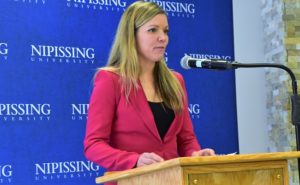Partnerships form to repatriate cultural items

By Kelly Anne Smith
NORTH BAY— A collaboration of First Nations, academics and museums will search for items to repatriate to home territories of the Robinson Huron Treaty of 1850.
Dr. Kirsten Greer, Associate Professor in the Departments of Geography and History and the Canada Research Chair in Global Environmental Histories and Geographies and research lead, outlined the details of the project funded by Social Sciences and Humanities Research Council (SSHRC) at a research showcase on Jan. 22 at Nipissing University.
Greer gave an overview of the project Reassembling Ontario’s “Near North”: Reparation through university-museum-Indigenous research partnerships.
“First Nation partners, regional, national and international museums and scholars across the humanities, social sciences and geophysical sciences reassemble and repatriate museum collections from the Robinson Huron Treaty of 1850 territory.”
“The innovative outcome of this research is having to use these historical collections to examine colonial encroachment and environment change overtime using materials such as historical maps, soil monoliths, timber samples and historical area photographs.”
“This project responds directly to the TRC Calls to Action and to the needs of our First Nation partners— Dokis First Nation and Nipissing First Nation. It also contributes to global environmental change research to address todays current environmental challenges from an interdisciplinary perspective. Museum partners include the Chicago Field Museum, Ingenium, Canada’s Museums of Science and Innovation and the North Bay Museum.”
Greer explained a second project on place-based reparative environmental histories which addresses the lack of Indigenous representation at international academic conferences, especially those that address contemporary and historical issues that Indigenous communities daily confront.
There will be an intervention at the American Society of Environmental History Conference using art creation across the conference hotel to highlight the traditional and unceded territory of the Algonquin in which the event is situated. Curation is by Anishinaabekwe Aylan Couchie of Nipissing First Nation, also a Nipissing University artist-in-residence.
Greer talks about the Ottawa exhibit in March.
“We are using the materials that we’ve researched and showcasing some of that at the hotel. As well, we are actually responding to the theme of the conference which is reparative environmental histories. We are really responding to the place in which we are doing our environmental research and where we hold these conferences. It’s at the Delta Hotel. We are going to do different installations throughout the hotel, either on the first floor or up into the penthouse.”
“We are also organizing circle sessions on the theme of reparation and repatriation for First Nation community members and scholars,” outlined Greer. “We are also organizing a day at the library at Archives Canada to extend partnerships with Nipissing First Nation, Dokis First Nation, to Kitigan Zibi Anishinabeg First Nation and to the Algonquins of Pikwàkanagàn First Nation. This is also to discuss shared histories and territories among all four of the First Nation communities.”
Greer says the first project is really capitalizing on research strengths.
“I do a lot of work on nineteenth century archives and material culture across museums in North America and the UK. It is locating items that had been collected, either without permission or by permission, in these museums. And doing the research and building relationships with those museums in order to start the whole process of repatriation, if that is possible, to bring these materials back home.”
“It’s bringing together our different approaches into one study so that we have a broader understanding. I also work with a dendrochronologist, someone that studies tree rings to reconstruct climate. We’ve been looking at different historical building samples. He can actually reconstruct the climate based on where those trees are from.”
“What also can be done is to use some of these materials such as aerial photos that were taken in the 1920s in order to look at environmental change over time or at landscape change over time.”
Nipissing First Nation’s Joan McLeod is excited about decolonizing Nipissing First Nation’s history. She attended along with Glenna Beaucage, Nipissing First Nation’s cultural and heritage manager.
McLeod says building relationships is important for the work.
“I like the partnerships in on it and really getting to know what it is. Say the North Bay Museum— what are their partnership needs? What does Dokis need? And then it goes out further into the traditional territory, the shared territory with other Nations.”
“I like the idea of decolonizing from a Native perspective,” says McLeod. She curated the extensive exhibit, Decolonizing the History of Nbisiing Traditional Territory, on display at the 2019 International Ploughing Match.
“That’s what we tried to do with our exhibit, was to make it come right from Nipissing then out to the public.”
Anthony Rota, Nipissing — Timiskaming MP and Speaker of the House of Commons, was on-hand to hear of the research studies. He called the funding direct investment in Canada’s future.


